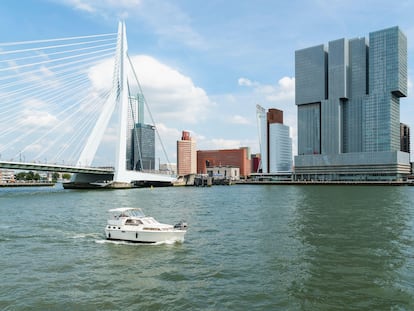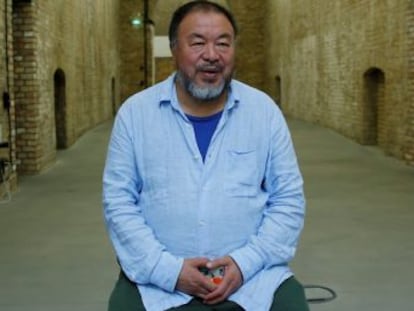Ai Weiwei: ‘In the art world, everyone talks about money. It’s poisonous; you’re only worth as much as your work’
China’s most famous artist lives quietly in Portugal. But exile is hard, even if it’s golden. On the occasion of his latest exhibition at the MUSAC, a contemporary art museum in the city of León, Spain, he shows EL PAÍS the first house he’s ever bought, at the age of 67

Don’t try asking Ai Weiwei about his net worth. The 67-year-old is one of the most sought-after artists in the world, but he doesn’t know how much he has in his bank account. Nor does he care.
“My father (the poet Ai Qing) made a living selling words. And I never heard him say ‘money.’ It doesn’t matter how much I have. [Rather, what matters is] what I use it for. I reinvest almost all of it in my projects. I don’t have my own car, I don’t go to expensive restaurants, I hardly have a social life. I only need what my father needed: a pencil and a piece of paper. Those are my most precious possessions. And time. And a good chat with family and friends. Everything else is useless.”
China’s most famous artist welcomes EL PAÍS on a sunny morning at the rural property that he has made his home for the past four years. It’s located about an hour from Lisbon, in Montemor-o-Novo, a municipality in the southern region of Alentejo. The question about his fortune is relevant because, as he shows us around the house, he notes that it’s the first time he has ever bought a property.
“I’m almost 70 years old. So, I [had to] invest in something, or I never would. In my country, nobody owns land; for me it’s like a miracle.” However, he refuses to call it home: “I’ll always be a stranger, an exile.”
On this 17-acre property, he’s accompanied by a single assistant, five cats (he had 40 in his studio in China), two Portuguese mastiffs and a colorful turaco — an exotic bird from Senegal, gifted to him by a local pet shop — who accompanies WeiWei with his songs. The bird lives in a large cage next to the rocking chair where the artist meditates in the evenings.
WeiWei prepares his own meals. “What I miss most is a Chinese cook,” he sighs. “I would love to hire one.” The mansion contains almost the same furniture as when he bought it. The only object that stands out is a piano. It’s there so that his 16-year-old son, Ai Lao (“old eye,” in Chinese) — who lives in Cambridge with his mother, the filmmaker Wang Fen — can practice when he visits. There’s also a swimming pool near the entrance. The artist invites EL PAÍS to conduct the interview alongside it.
He has settled in this part of Portugal, he explains, because when he came to stage an exhibition in Lisbon, this wild terrain reminded him of the landscape of his childhood. Born in Beijing, he grew up in the Xinjiang province, in the northwest of China, a stone’s throw from the Gobi Desert.
He shows EL PAÍS the wallpaper on his phone: the image is a worn, black-and-white photo of a hole dug in the ground. It’s just a few square feet in size. “This is the underground bunker where I lived my first years, when my father went from being a [renowned] intellectual to a traitor, condemned to forced labor. He was forced to clean the communal latrines. We had $6 a month and a box of matches per family, to have light, to keep warm and to cook. I remember that my pockets were full of holes… but I didn’t care, because I had nothing to put in them.”
“Nowadays, everyone talks about money… something that I consider, socially, to be very poisonous. And, in the art world, even more so: you’re only worth as much as your work. It’s very crazy, a disease. But it’s human nature.”
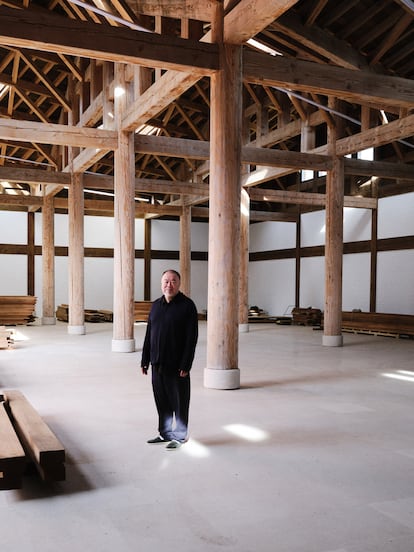
Ai Weiwei has made political denunciation his main cause, but he doesn’t see himself as an activist. “You only use that word in the West,” he chuckles. “In my country, there’s no clear term that defines people like me. We’re just called ‘troublemakers.’”
His eventful history has been heavily documented, both by the media — he gives more than 100 interviews a year, he keeps count — and by himself. He’s often the protagonist of his work and spends a good part of his time on social media. He’s not afraid that overexposure will undermine his credibility. On the contrary. “I act as a spokesperson for millions of underrepresented people, who aren’t given a voice.” He staged this in the piece that made him a world-famous artist. Back in 2010, his installation at the Tate Modern in London displayed 100 million porcelain sunflower seeds. Painted one by one in small workshops, the artist emphasized the “made in China” approach, while alluding to the idea that “all Chinese people are different… you just have to look closely at their differences.”
Just a few months later, in April of 2011, Ai Weiwei disappeared after being arrested at the airport in Beijing. He had been bothering the Chinese government since he opened his blog in 2005, which had more than 20 million readers. In it, he collected the names of more than 5,000 children who died when the precarious state schools (derided as “tofu buildings”) collapsed in the Sichuan earthquake of 2008. The authorities shut down his blog. He then shifted to Twitter.
The Chinese government turned WeiWei’s house into the most surveilled one in the country, with 15 cameras pointed at it. He hung red lanterns on them to make them even more conspicuous. He still thinks that “the obsession with surveillance and social control responds to a staging of power.”
“Living under surveillance has become an essential part of being alive,” he says. “The only thing that cannot be monitored is what goes on in our heads.”
Along the way, he closed down the design company he ran for 10 years — called FAKE, because it sounded like “fuck” — after collaborating with the architectural firm Herzog & de Meuron on the 2008 Olympic stadium. “I got tired of the bureaucracy involved in building in China, but above all, I got angry when I saw the Olympic Games turned into a propaganda mechanism for the Communist Party that left out the citizens,” he grumbles.
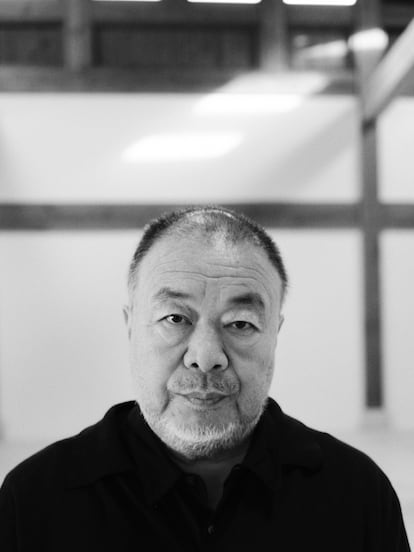
After his arrest, Weiwei was detained for 81 days. During that time, he was interrogated daily and had two guards supervising him at all times, even when he was sleeping or using the bathroom. Seeking his silence, they made his voice louder. Time included him among the 100 most influential people in the world. ArtReview proclaimed him the most powerful artist of the year.
WeiWei eventually reappeared on bail. Chinese state media reported that he had confessed to tax evasion. He was fined the equivalent of $2.4 million and released on the conditions that he not give interviews, use social media, or travel.
During his house arrest, WeiWei installed cameras inside his home to broadcast his life online, proving how innocuous the existence of a person so dangerous to the regime could be. The website was censored. As soon as he got his passport back, he flew away. He spent five years in Berlin, declaring in an interview with The Guardian that “Nazism perfectly exists in German life today,” and another five in London.
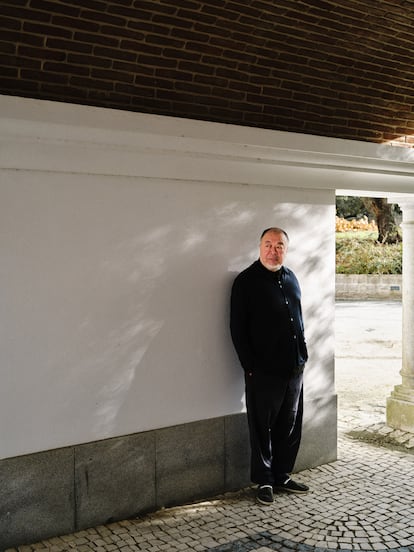
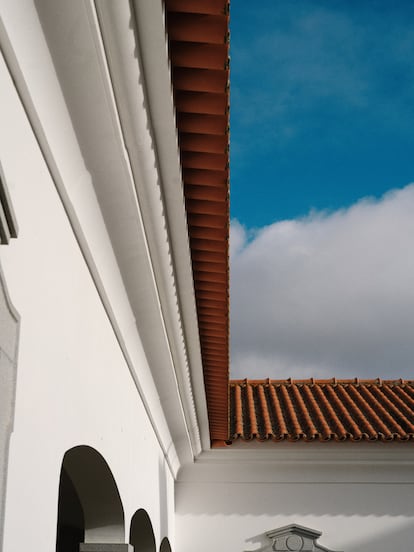
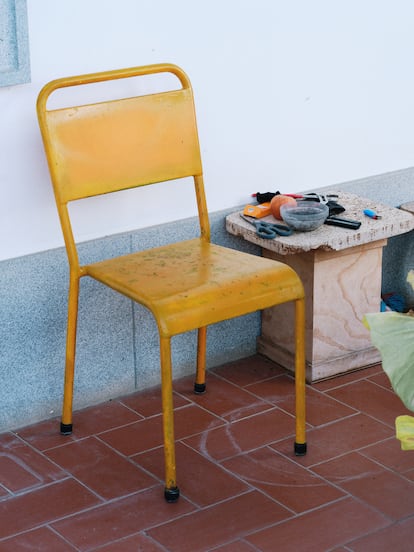
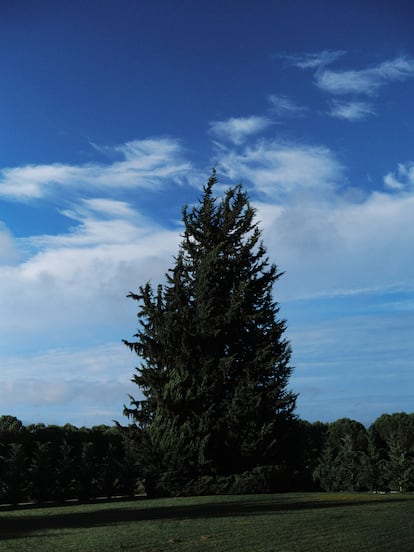
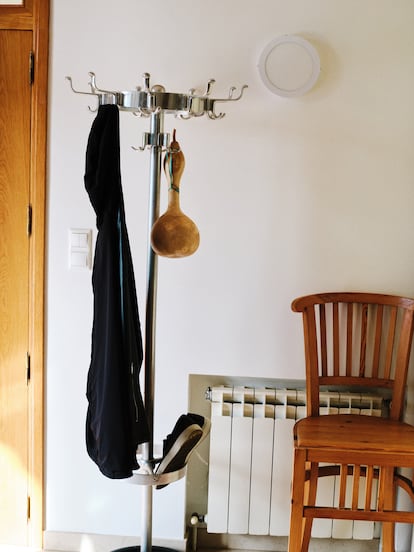
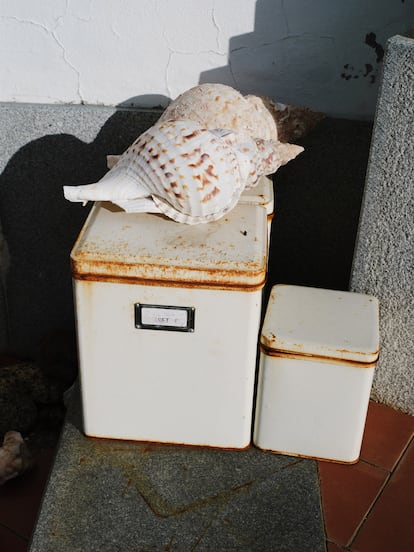

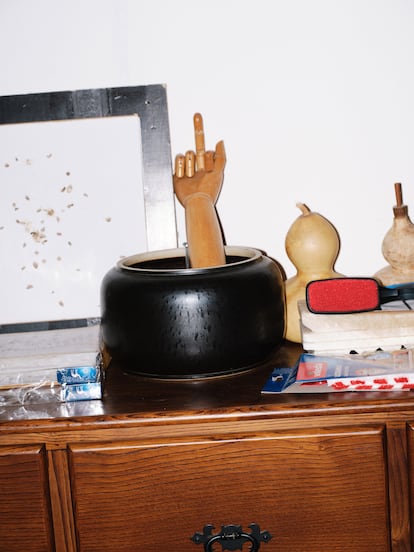
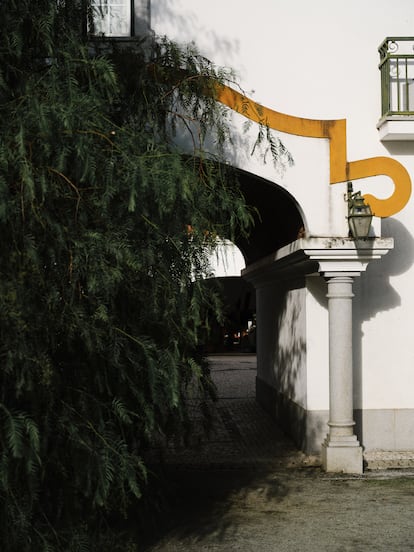



Today, in the Portuguese region of Alentejo, the artist has rediscovered the meaning of the word “patience.”
“It’s something that I’ve had to cultivate a lot over the years. But the Portuguese live at a different pace, much slower. I can see this with the workers I’ve hired to build my new studio,” he says wryly.
WeiWei strolls with EL PAÍS along a poplar grove to a 32,000-square-foot mass that sits in the middle of nowhere. It’s an exact brick-and-wood replica of the workshop that was demolished by the authorities in Shanghai back in 2011. From here, the artist supervised the exhibition that the MUSAC, a contemporary art museum in the city of León, Spain, is hosting until May 18. Imitations of paintings made with LEGO blocks stand out.
“They produce a pixel effect,” he explains. “[And they] have a palette limited to 40 colors and are a neutral material.” He recreates classic canvases with some modifications: in Hokusai’s The Great Wave (1831), the boat is a rickety migrant vessel; in Goya’s The Third of May 1808 (1814), he includes his face among those being executed.
WeiWei also uses LEGO to recreate photographs from his career: the defiant selfie in the mirror of an elevator, next to the police officer who had just arrested him; the photo he took imitating Aylan, the drowned Syrian child, on a Turkish beach; or the most famous triptych from his early days, dropping a thousand-year-old urn from the Han dynasty to denounce the lack of preservation of Chinese heritage.
When asked about the iconic photo in which he shatters a relic, the artist replies: “Mao proclaimed that the old world had to be done away with, in order to build a new one. He destroyed collective memory. That’s why my historical education was non-existent. So, after returning from New York in 1993, I went to an antique market to touch those objects and deduce that past.”
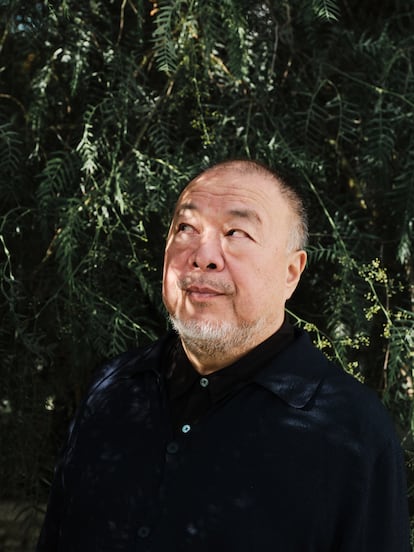
After Mao’s death, in 1976, WeiWei’s family returned to Beijing. Disillusioned with the film academy, he managed to get a visa thanks to a girlfriend’s connections. “I chose New York, for two reasons: for communist China, the U.S. is the great enemy. Going there made me a traitor, but I needed to see it. [And] it was also the main stage for world art.” He landed there at the age of 24, fascinated by Duchamp and Warhol. He scraped by as a handyman, while also painting portraits of tourists in Times Square. That’s when he began taking photos.
“In the East Village, drug addicts would gather to sell their junk, to get a fix. There, I got a Linhof camera for $20. At first, I used it to photograph city life… but I discovered its potential during the Tompkins Square Park riot in 1988, when residents and street people stood up to police abuse in the neighborhood. [Around then], I understood the challenge that an image can pose for the authorities.”
WeiWei barely integrated himself into the local scene. One night, in 1985, he ran into Allen Ginsberg, the beatnik poet, in a bar. The American was reciting poems by WeiWei’s father. “He introduced him by saying: ‘In China, I met this poet who should be considered a national hero… and they had him cleaning toilets.’ I approached him and said: ‘That was my father. ' He became my ‘uncle Ginsberg’ until I went back to Beijing, precisely because my father was ill.” Ai Qing would die three years later. By then, his artist son was already taking shape.
“I had to [snap out of it]. My mother told me: ‘You’ve been gone for 12 years, [but nothing has changed].’ I had no education, no money. I didn’t even know how to drive. I did odd jobs for years to survive,” he recalls. His mother, who’s now 92 years old, refuses to let him visit her in China again, although he hopes to see her before she dies.
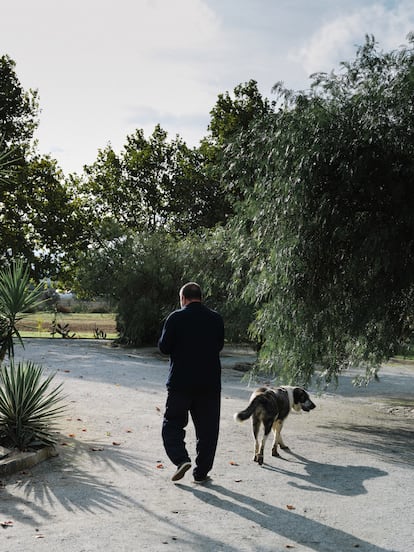
He has titled the MUSAC exhibition Don Quixote, after his favorite fictional character. “When I was 10, we were forced to burn all my father’s books, including his poetry collections by Lorca and Neruda, [the latter of whom] was also a friend of his. And there was always one [character] that caught my attention, Don Quixote, with those illustrations of a tall man with a spear and the fat man on a donkey beside him. Perhaps I owe my first impulse to draw to them.”
“[Don Quixote] fired up my imagination beyond the Maoist doctrine, which dictates that everything must conform to what is rational. I find [the story] very symbolic: the fight against windmills, that romanticism of a man who’s considered crazy… it represents what every artist should be. We’re often [denounced as being] ‘idiots’ or ‘ridiculous,’ but we have to defend our own identity,” he shrugs.
WeiWei protects himself by keeping some distance from the art system, preferring to concentrate on his work. “I have no free time. I never go on holiday or on a trip for pleasure. I don’t even go to museums. If I can avoid it, I don’t even go to my own openings.” A few days later, he contradicted himself by showing up at the MUSAC.
Before concluding the interview, he takes out his phone again and asks to take a selfie together. “I like to document everything.” I grab my own phone, to imitate his gesture. Then, he takes it from me, to take the photo himself. “This way, you have an original.” And he clicks.
Translated by Avik Jain Chatlani.
Sign up for our weekly newsletter to get more English-language news coverage from EL PAÍS USA Edition
Tu suscripción se está usando en otro dispositivo
¿Quieres añadir otro usuario a tu suscripción?
Si continúas leyendo en este dispositivo, no se podrá leer en el otro.
FlechaTu suscripción se está usando en otro dispositivo y solo puedes acceder a EL PAÍS desde un dispositivo a la vez.
Si quieres compartir tu cuenta, cambia tu suscripción a la modalidad Premium, así podrás añadir otro usuario. Cada uno accederá con su propia cuenta de email, lo que os permitirá personalizar vuestra experiencia en EL PAÍS.
¿Tienes una suscripción de empresa? Accede aquí para contratar más cuentas.
En el caso de no saber quién está usando tu cuenta, te recomendamos cambiar tu contraseña aquí.
Si decides continuar compartiendo tu cuenta, este mensaje se mostrará en tu dispositivo y en el de la otra persona que está usando tu cuenta de forma indefinida, afectando a tu experiencia de lectura. Puedes consultar aquí los términos y condiciones de la suscripción digital.
More information
Archived In
Últimas noticias
All the effects of gentrification in one corner of Mexico’s Colonia Roma
Palestinian reporter Youmna El Sayed: ‘My family told me I had to choose between being a journalist or a mother’
The new language of the workplace: Knowing how to ask AI questions is more important than using it
Russell Tovey: ‘I was advised many times not to come out, I don’t think there was many people who’d done that — and I feel really proud that I’m one of those that did’
Most viewed
- The low-cost creative revolution: How technology is making art accessible to everyone
- Families demand repatriation of bodies of Colombians who died in Ukraine: ‘This war is a slaughterhouse for foreigners’
- Christian Louboutin: ‘Young people don’t want to be like their parents. And if their parents wear sneakers, they’re going to look for something else’
- US sanctions against jailed cartel leader ‘El Marro’ highlight Mexico’s lack of control over its prisons
- Liset Menéndez de la Prida, neuroscientist: ‘It’s not normal to constantly seek pleasure; it’s important to be bored, to be calm’
